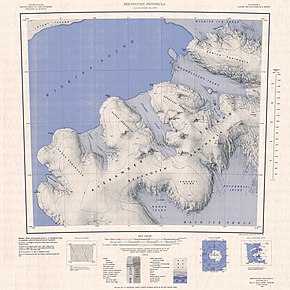Beethoven Peninsula
| Beethoven Peninsula | ||
 Topographic map sheet Beethoven Peninsula 1: 250,000 |
||
| Geographical location | ||
|
|
||
| Coordinates | 71 ° 44 ′ S , 73 ° 41 ′ W | |
| location | Alexander I Island , West Antarctica | |
| Waters 1 | Wilkins Sound | |
| Waters 2 | Bach Inlet | |
| length | 100 km | |
| width | 100 km | |
The Beethoven Peninsula ( called Península Carvajal in Chile ) is a jagged and icy peninsula which, with a length of 100 km in a north-east-south-westerly extension and 100 km at its widest point, characterizes the south-west of the Antarctic Alexander I Island . It separates Wilkins Sound in the north from Bach Inlet in the south.
The Beethoven Peninsula is a volcanic field , the volcanoes in the Pleistocene were active. The youngest dated rocks are 0.68 million years old.
It was sighted and photographed from the air in 1940 during the United States Antarctic Service Expedition (1939–1941), during which the first rough map of the southwest of Alexander I Island was created. It was spotted again and also documented by aerial photographs during the American Ronne Antarctic Research Expedition (1947–1948). These photographs were used by the British geographer Derek Searle of the Falkland Islands Dependencies Survey in 1960 for a detailed mapping. The UK Antarctic Place-Names Committee named it after the German composer Ludwig van Beethoven (1770-1827).
Web links
- Beethoven Peninsula in the Global Volcanism Program of the Smithsonian Institution (English)
- Beethoven Peninsula in the Geographic Names Information System of the United States Geological Survey (English)
- Beethoven Peninsula on geographic.org (English)
Individual evidence
- ↑ Carvajal, Península. In: Gazetteer - Australian Antarctic Data Center. Australian Government - Department of the Environment and Energy - Australian Antarctic Division , accessed March 13, 2017
- ^ John L. Smellie: Lithostratigraphy of Miocene-Recent, alkaline volcanic fields in the Antarctic Peninsula and eastern Ellsworth Land . In: Antarctic Science . tape 11 , no. 3 , September 1999, ISSN 0954-1020 , p. 362–378 , doi : 10.1017 / S0954102099000450 (English, freely available online through researchgate.net ).
